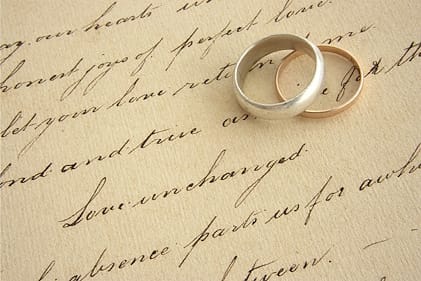
If you’re choosing to write your own wedding vows, congrats on taking on this important task!
Vows are arguably the most memorable part of any wedding. Sure, the “I dos” are important, but they’re mainly a legal formality. The promises you share with your partner, in front of family, friends, and everyone gathered for the occasion, constitute the heart of a wedding ceremony – so it’s crucial that you prepare properly and be intentional about what you say.
Even if you opt for private vows (more on this later), you’ll want to devote the same time and attention that the vow-writing process deserves.
Naturally, the goal is to craft vows that truly reflect your relationship and resonate with your partner. As you prepare to express your commitments to each other, remember this is your opportunity to share your love story, make personal promises, and speak directly to the future you're eager to build together.
Whether you're aiming for words that are poetic, humorous, or profoundly heartfelt, we’ve created this guide to writing wedding vows that are as unique and special as your relationship.
Here are our 10 key tips for writing wedding vows:
1. Start Early
Procrastination is the arch nemesis of good wedding vows. Well before the big day, begin reflecting on your relationship and what you want to say. Starting early removes the pressure of having to create something perfect right before the cutoff (and allows you plenty of time to crumple up pieces of paper and toss them over your shoulder dramatically).
2. Find Inspiration
Read other vows, love poems, or romantic literature to spark ideas. Listen to songs that hold special meaning for you and your partner. Think about what makes your partnership special. For more examples of what your vows could look like, check out these sample wedding vows.
3. Reflect on Your Relationship
Consider the elements that define your relationship that could make for good themes to build on. Think about things like:
- How you met: What drew you to each other?
- Key moments: Weigh both the highs and the lows that have strengthened your bond.
- Growth: How have you both evolved since being together?
- Unique elements: What makes your relationship stand out?
4. Decide on the Tone
Do you want your vows to be funny or deeply emotional? Plainly written or poetic? Or perhaps a mix of multiple elements? It’s important you be on the same page about this with your partner to avoid a scenario where you take the humorous route and their vows are really deep, for example.
You certainly don’t need to share your ideas word for word with them, but aligning on the tone beforehand will ensure your vows complement one another.
5. Outline Your Vow Structure
Vows can be as short or as long as you want, though most experts agree that roughly 3-5 minutes is the sweet spot. Using that guideline, you’ll have enough time to break your vows into a few pieces (which can be helpful when it comes time to write, too):
- A brief opening about how important your partner is to you.
- Personal stories or anecdotes that highlight your bond.
- Promises that are both meaningful and realistic.
- A closing that looks forward to your shared future.
6. Make Your Promises Count
Vows are essentially a series of promises. These can range from profound statements like supporting each other even in the darkest times, to lighter commitments, like always making coffee for your partner in the morning.
Clichés are common here; do your best to avoid them. Make your commitments personal to who you are as a couple.

7. Practice Out Loud
Reading your vows aloud as you write can help refine them. Practicing will help you make any necessary adjustments to ensure your vows sound just right. It’s also crucial to do a couple dry runs so you know (roughly) what you’re going to say on the day, even if it’s through teary eyes.
8. Keep a Surprise Element (Optional)
While it’s okay to coordinate the tone and structure with your partner, keeping some elements of your vows a secret is one way to make the moment more special and memorable. This isn’t a requirement, but some thoughtful words or a (tasteful) funny story they didn’t see coming can add a nice touch.
9. Seek Feedback
If you’re comfortable, share your vows with a trusted friend or family member who can provide constructive feedback. Alternatively, if you’re okay with your partner seeing part (or all) of your vows before the big day, the ultimate peace of mind would be to get their official sign off. Of course, that options removes the element of surprise. There are always tradeoffs.
10. Don't Forget About Presentation
Once you’ve settled on what you want to say, you’ll need to decide how you will present your vows. Will you read them from a device, have them in a vow book, or recite them from memory?
We generally recommend against reading from a phone or tablet, as this can make the experience feel a bit less genuine. For those who can’t commit a high-pressure 5-minute speech to memory (that’s most people, by the way – don’t feel bad), a vow book or note cards can be a great option. At the end of the day, do what’s best for you.
Public vs. Private Vows – Which Should You Choose?
Traditionally, personalized vows are recited publicly in front of the audience during a wedding ceremony. This can be quite a meaningful part of the ceremony, and allows the guests a peek into your relationship. But that’s not the only way to go about things. If you and your partner want to write your own vows but would rather not share the spotlight in that manner – that’s fine!
An alternative option that some couples opt for is to write personalized vows and share them privately, typically in advance of the ceremony. This can take some of the pressure off – and it also reinforces the fact that the day is about you, not other people. It’s your little private moment that nobody else gets to experience.
Regardless of what you choose to do, following the steps laid out above can help you craft vows that not only resonate with your partner, but that you two can cherish together as a memorable part of your love story.

